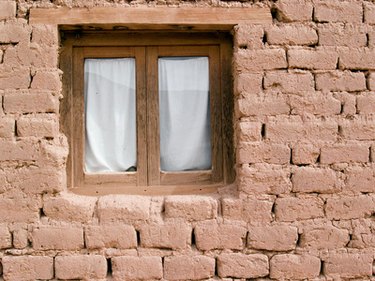Things You'll Need
Jar with a lid
Dirt
Water
1 tsp. salt
3, 6-foot 2 x 4 pieces of lumber
Measuring tape
Saw
Hammer
Nails
Shovel
Hoe
Liquid Asphalt Emulsion or Portland cement

Building codes in many areas of the United States require builders to add a stabilizer such as liquid asphalt emulsion or Portland cement to adobe bricks when they are formed. Semi-stabilized adobe bricks are partially stabilized to protect them from rain damage during the drying process. Fully stabilized adobe bricks are highly water resistant and can be exposed to the elements with less danger of cracking or erosion. Adobe bricks are stabilized by adding a small amount of a stabilizer to the mud mixture.
Step 1
Conduct a sedimentation test to determine the percentage of clay, sand, and silt present in your soil. Fill a jar two thirds full of soil, add water, and 1 tsp. of salt and shake for 2 minutes. Put the jar down. The dirt will settle into layers of sediment with clay on top, silt in the middle, and sand and other aggregates on the bottom. The sedimentation test allows you to determine the percentage of each component present in your soil. According to Quentin Wilson of Green Home Building, an ideal mixture contains 15 to 30 percent clay, very little silt, and the rest sand.
Video of the Day
Step 2
Construct an adobe brick form, or mold, from 2 x 4 pieces of lumber. In the Southwestern United States, adobe bricks are traditionally 14 inches long by 10 inches wide and 4 inches tall. Measure and cut two lengths of wood 5 feet long with your saw. Cut a third 2 x 4 into six sections that are 14 inches long. Starting at the end, nail the 14-inch sections between the 5-foot lengths of wood every 10 inches. The finished form will resemble a small ladder and can make up to five adobe bricks at a time.
Step 3
Prepare a mixing area. For big jobs, dig a mixing pit about 4 feet across and 2 to 3 feet deep. In its publication, "ABCs of Making Adobe Bricks," the New Mexico State University College of Agriculture and Home Economics says to stabilize the walls of your pit, you should fill it with water and let the water soak in for 12 hours before you mix your mud. For smaller jobs, you can mix the mud on a tarp, in a wheelbarrow, or even in a 5-gallon bucket. For convenience, put your mixing spot adjacent to the sunny area where you will form and dry your bricks.
Step 4
Choose a stabilizer. You can stabilize your bricks with liquid asphalt emulsion or Portland cement. For semi-stabilized adobe bricks, add 3 to 5 percent asphalt emulsion or Portland cement by weight to your adobe dirt. For fully stabilized adobe bricks, add 6 to 12 percent asphalt emulsion or Portland cement by weight to your mix.
Step 5
Mix your mud. Slowly add water to your adobe dirt and mix it together with a shovel or hoe. Add just enough water to form a stiff mud. Break up any lumps of dirt with your shovel. Add your stabilizer and continue mixing until you have a consistent mixture.
Step 6
Shovel the mud into the adobe brick form. Use your shovel to tamp the mud down in the mold and eliminate air pockets. Push the mud into all of the corners. Use a piece of 2 x 4 to level off the brick. Allow the mud to set up for at least 20 minutes before removing the form.
Step 7
Remove the form. The bricks should retain their shape. Wash the form off. Leave the bricks to dry in the sun. When the edges of the bricks are dry, turn them on their sides and allow them to continue drying for several more weeks.
Tip
Making stabilized adobe bricks is a process of trial and error. Start with a small batch to make sure that your mixture produces a strong brick.
If your bricks stick to the adobe form, wet the form before adding the mud.
Video of the Day
- New Mexico State University College of Agriculture and Home Economics: ABCs of Making Adobe Bricks
- "Home Energy Magazine Online": Earth Building Takes New Shapes
- New Mexico Energy, Minerals and Natural Resources Department: Modern Adobe in New Mexico
- Green Home Builders: Ways to Make Adobe Bricks
- "Mother Earth News": The Owner Built Adobe House